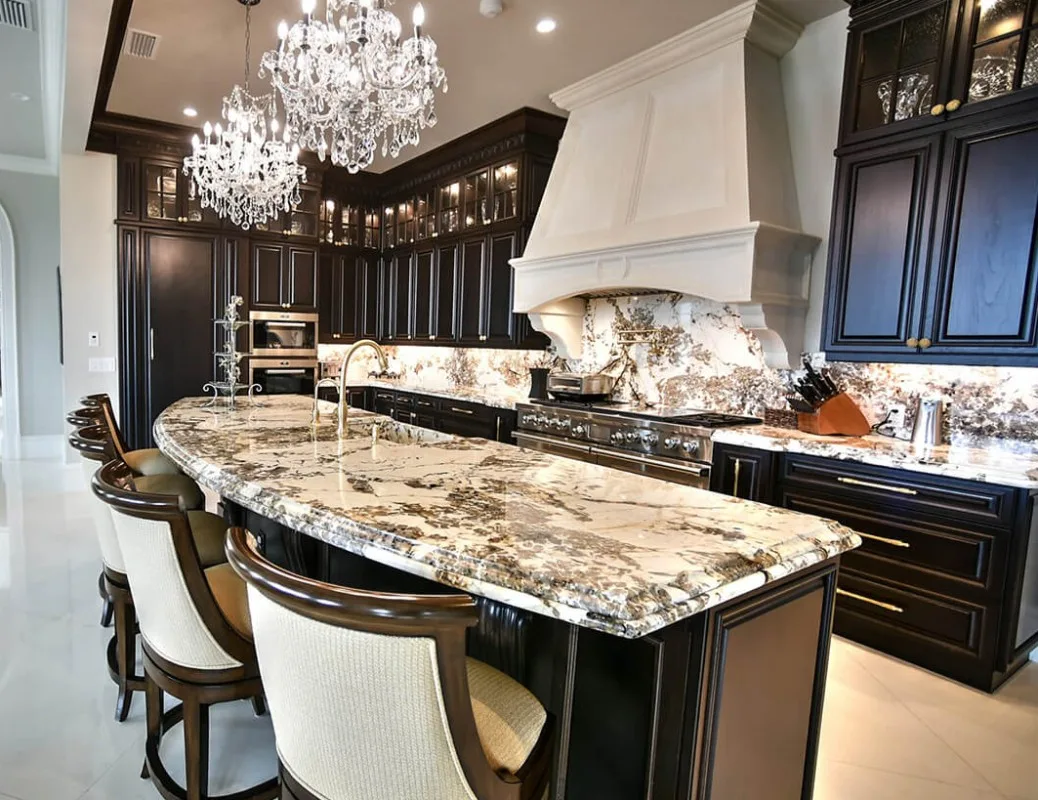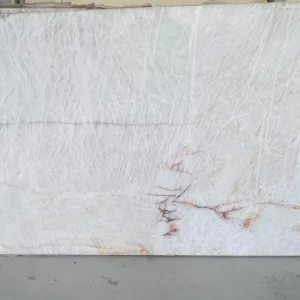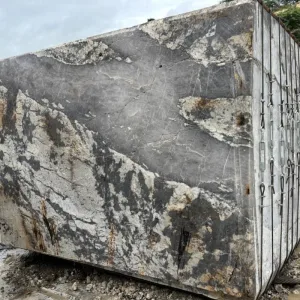Patagonia Quartzite originates primarily from Brazilian quarries, with secondary sourcing from northern Indian states including Rajasthan and Gujarat. Named after the picturesque Patagonia region of South America known for breathtaking landscapes and natural beauty, this quartzite captivates with extraordinary appearance and exceptional geological characteristics formed over millions of years through metamorphic transformation.
The stone forms when sandstone containing quartz minerals undergoes extreme heat and pressure deep within Earth’s crust, causing mineral grains to recrystallize into an interlocking mosaic structure. This metamorphic process creates Patagonia’s distinctive 93% quartz composition- significantly higher than typical quartzites and responsible for the material’s exceptional hardness, durability, and unique visual characteristics including translucent properties and crystalline shimmer.
Brazilian Patagonia exhibits predominantly white or light grey background interwoven with bold, dynamic veining in shades of black, grey, and occasional hints of gold or brown. The intricate patterns and rich color variations evoke the rugged landscapes of its namesake region. Indian Patagonia from Rajasthan and Gujarat presents soft white base with beige veining and notably high light permeability—a favorite among architects and designers for translucent applications. The Patagonia Green variety features intense emerald-green background with earthy amber and grey veining, white, pink, ochre, and gold accents creating unique enchanting effects.
What truly distinguishes Patagonia quartzite is its distinct book-matched cutting method employed during extraction and processing. When consecutive slabs are cut from the same block and finished to mirror each other, they create perfectly symmetrical masterpieces—like nature’s perfect twins. Most Patagonia applications including kitchen countertops, floors, walls, and dining tables require this book-matching technique, creating seamless, dramatic patterns across installations. The spectacular disruptive aspect of Patagonia results from explosion of tones and contrasts it presents—thousands of black, grey, and ochre portions bursting across bright beige canvas.
Buyers specify Patagonia for luxury residential kitchen countertops combining durability with artistic beauty, bathroom vanities transformed into elegant focal points, commercial hospitality lobbies requiring statement materials, book-matched feature walls creating mirror-image dramatic installations, dining and coffee table tops as conversation pieces, backlit applications where translucent properties create stunning illuminated effects, seamless indoor-outdoor installations extending to alfresco areas, floor-to-ceiling shower panels adding spa-like elegance, fireplace surrounds, monument construction, and custom furniture requiring exceptional hardness and visual impact.
Performance and Quality
Patagonia Quartzite demonstrates performance characteristics positioning it among the most durable natural stones available for architectural applications. Ranking 7-8 on Mohs hardness scale, Patagonia significantly surpasses granite (6-7) and dramatically exceeds marble (3-5), making it exceptionally scratch-resistant even compared to steel knives (7 on scale). This extreme hardness translates to surfaces that maintain smooth, polished finish for decades even with regular use and heavy traffic.
Patagonia is so hard that using knives directly on its surface risks dulling knife blades rather than scratching the stone—though cutting boards remain recommended for both stone and knife preservation. The high density (2.65-2.90 g/cm³) and minimal water absorption (0.3%) create natural stain resistance superior to many other natural stones, with non-porous characteristics restraining bacteria and dirt accumulation for hygienic food preparation surfaces.
Heat and fire resistance represents another standout performance attribute. Quartzite withstands temperatures up to and above 150°C (300°F) without cracking, chipping, or damage, making it ideal for surfaces around fireplaces, ovens, grills, and other heat-generating appliances. However, users should still employ trivets or hot pads for cookware placed directly from heat sources to prevent potential thermal shock and protect against discoloration over time from prolonged extreme heat exposure.
The unique crystalline structure causes natural voids within Patagonia slabs. Industry-standard practice involves filling these natural voids and cracks with clear epoxy resin during polishing processing, ensuring structural integrity and smooth surface finish without affecting the stone’s performance or aesthetic appeal. The fragmented nature combines minerals of different colors, appearance, and sizes, with irregular aesthetics breaking uniformity of light—capable of alternating in same slab from 100% opaque fragments to beautifully translucent surfaces perfect for unique backlighting effects.
Flexural strength averages 39.1 MPa according to ASTM C880 testing, supporting cantilever and spanning installations. Chemical resistance according to ASTM C650 confirms suitability for environments with cleaning product exposure. Frost resistance per ASTM C1026 verifies exterior application performance in freeze-thaw climates when properly sealed and maintained.
Expected service life for interior Patagonia installations exceeds 40-50+ years with proper maintenance. The combination of hardness, heat resistance, and stain resistance results in surfaces maintaining natural, timeless beauty for decades without fading, discoloring, or wearing down easily—allowing polished, glossy finish retention with minimal upkeep.
Materials and Construction
Patagonia undergoes specialized quarrying and processing preserving its unique translucent properties while ensuring structural integrity. Brazilian quarries employ modern extraction techniques including wire saws and controlled methods minimizing micro-fracturing—critical for maintaining book-match quality and light transmission capabilities essential for premium applications.
After extraction, blocks transport to processing facilities equipped with gang saws using diamond-wire cutting technology. Consecutive slabs intended for book-matching require precise cutting maintaining mirror-image perfection—slight variations in cutting angle or blade positioning disrupt symmetrical patterns buyers expect. The 93% quartz composition makes Patagonia harder to work with than softer marbles, requiring specialized diamond tooling, slower cutting speeds, and expert fabrication techniques.
The polishing process progresses through multiple grinding and buffing stages using progressively finer diamond abrasives, revealing the stone’s crystalline surface and translucent qualities. Polished finish enhances natural luster, highlights intricate veining, and creates sleek glossy surface exuding elegance. Honed finish provides matte appearance showcasing unique characteristics with more understated sophistication. Both finishes available in 20mm standard thickness with large-format options utilizing Stonesize lightweight panel system starting from 10mm thickness for reduced weight without sacrificing strength.
Top-quality Patagonia availability remains very limited due to rarity of blocks exhibiting optimal characteristics—minimal natural imperfections, larger dimensions, superior quartz content, and best translucency for backlit applications. Basic quality with more beige color and less pronounced quartz content maintains higher availability at lower price points. The unique character of each slab means pricing reflects block quality and negotiation between fabricators and quarry owners.
Parameter |
Description |
| Slab Sizes | Gang Saw Slabs: 280 x 180 CM up in 2, 3 CM, and other Cutter Slabs: 180 x 60 CM up in 2, 3 CM, and other |
| Tiles | 30×30, 30×60, 40×40, 60×40, 60×60, 60 x 90, 60×120 CM in various thicknesses and custom sizes |
| Thickness | 6 mm, 18 mm, 20 mm, 30 mm & custom options |
| Finishes | Polished, honed, leathered, lepatora, flamed, shotblasted |
| Standard Thickness | 18 MM (other thicknesses available) |
| Place of Origin | Brazil ,India |
Maintenance and Care
Patagonia Quartzite requires straightforward maintenance protocols reflecting its durable, low-porosity nature. Daily cleaning needs only mild soap diluted in warm water, applied with soft microfiber cloth or non-abrasive sponge. Avoid harsh cleaners, abrasive scrubbers, or products containing acids, ammonia, or bleach that may damage surfaces or degrade sealer protection over time.
Despite quartzite’s inherent stain resistance, apply quality impregnating sealer periodically to maintain optimal protection against moisture penetration and staining from oils or pigmented liquids. High-use kitchen countertops benefit from annual sealing; low-traffic applications like feature walls may extend sealing intervals to 2-3 years. Test sealer effectiveness by placing water droplets on surface—if absorption occurs within 15-20 minutes rather than beading, resealing is recommended.
Always use cutting boards when preparing food, even on ultra-hard quartzite. While the stone resists scratching better than most materials, sharp tools can potentially leave marks with aggressive use, and direct cutting damages knife edges as quartzite’s hardness dulls blades. Place trivets, hot pads, or heat-resistant mats under hot cookware to prevent potential thermal shock and protect sealer from heat degradation.
Wipe spills immediately using blot method rather than wiping motions spreading liquids across larger areas. While Patagonia’s 0.3% water absorption provides excellent stain resistance, prolonged exposure to coffee, wine, oils, or acidic substances can potentially penetrate if sealer has degraded. For outdoor installations, establish biannual sealing schedule protecting against weather exposure and temperature fluctuations.
Installation and Compatibility
Professional installation by experienced fabricators familiar with quartzite is essential due to Patagonia’s exceptional hardness and premium value. The 7-8 Mohs hardness makes it more challenging to work with during fabrication compared to softer materials—cutting, drilling, and edge finishing require specialized diamond tooling rated for ultra-hard stones, slower cutting speeds, and expert technique preventing chipping or tool damage.
For countertop installations, fabricators create precise templates accounting for sink cutouts, cooktop openings, and desired edge profiles. Book-matched installations require additional planning ensuring slabs align perfectly to create mirror-image symmetry. Diamond-blade wet saws with continuous rim blades designed for hard quartzite ensure clean cuts without edge chipping. Installation typically requires 4-6 days for standard residential kitchen configurations—longer than granite or marble due to material’s exceptional hardness demanding slower, more careful work.
For flooring installations, use high-quality polymer-modified thinset mortar designed for hard natural stone. Substrate must be perfectly level, stable, and appropriate for stone’s weight (approximately 13-15 lbs per square foot for 2cm thickness). Floor deflection must not exceed industry standards to prevent cracking from structural movement.
Grout selection affects final appearance. Unsanded grout prevents scratching polished edges during application. Light grey, warm beige, or soft white grout harmonizes with the stone’s natural veining. Epoxy grout provides superior stain resistance for kitchen applications.
Pros & Cons
Advantages
- Exceptional hardness: Mohs 7-8 rating exceeds granite and marble; superior scratch resistance maintains polished finish for decades
- Book-match capability: Consecutive slabs mirror perfectly for symmetrical dramatic installations impossible with other stones
- Translucent properties: Light-permeable zones create stunning backlit effects for countertops, bars, and feature walls
- Heat and stain resistant: Withstands 150°C+ temperatures and 0.3% water absorption; ideal for high-use kitchen and outdoor applications
Considerations
- Premium pricing: $80-$200/sq ft reflects rarity, quality variation, and processing complexity; significantly higher than standard granite
- Installation complexity: Ultra-hardness requires specialized diamond tooling and expert fabricators; longer installation time than softer stones
- Quality variability: Dramatic block-to-block differences in quartz content, translucency, and veining require careful slab selection and inspection
Who Should Buy
Ideal Buyers
- Luxury residential renovators seeking ultra-premium natural stone with exceptional durability and unique book-matched aesthetics
- Contemporary designers creating dramatic mirror-image feature walls, backlit bars, or statement countertops requiring translucent properties
- Commercial hospitality developers specifying high-traffic lobby flooring, restaurant counters, or spa surfaces demanding beauty and extreme durability
- Outdoor living enthusiasts requiring heat and freeze-resistant natural stone for exterior kitchens, alfresco dining countertops, or patio surfaces
- Design-focused buyers who appreciate natural stone authenticity, understand quality tier differences, and commit to proper slab selection and inspection
Not Recommended For
- Budget-conscious projects where cost is primary concern over aesthetics (consider standard granite at $40-$70/sq ft)
- Buyers expecting perfectly uniform appearance with zero natural variation (consider engineered quartz)
- DIY installers without professional-grade diamond tooling rated for Mohs 7-8 materials and quartzite fabrication experience
- Projects requiring immediate material availability without flexibility for block sourcing and quality selection timelines
- Buyers unwilling to inspect actual slabs before purchase or unable to specify exact quality characteristics needed
FAQs
Q1: Is Patagonia Quartzite harder than granite, and what does that mean practically?
Yes, Patagonia ranks 7-8 on Mohs scale, surpassing granite’s 6-7 rating. Practically, this means superior scratch resistance- the stone is so hard it can dull knife blades rather than being scratched by them. Surfaces maintain polished finish for decades even in high-traffic kitchens. However, this hardness requires specialized diamond tooling during fabrication, increasing installation costs compared to softer materials.
Q2: Why does Patagonia Quartzite need epoxy filling, and does it affect quality?
Patagonia’s unique crystalline structure with 93% quartz content creates natural voids within slabs. Industry-standard practice fills these voids with clear epoxy resin during polishing to ensure structural integrity and smooth surface finish. This does not indicate quality deficiency- it’s inherent to the stone’s geological formation and actually enhances durability by preventing crack propagation. The epoxy is invisible in finished installations.
Q3: What’s the price difference between basic and “Extra” grade Patagonia?
Basic grade Patagonia with more beige color and less pronounced quartz runs $80-$100/sq ft and remains “highly available.” Extra/Premium grade with high quartz content, dramatic veining, and optimal translucency commands $120-$200/sq ft but faces “very limited availability.” The $120 price range within the same stone variety reflects block-to-block quality differences determined by geological factors during formation.
Q4: Can Patagonia Quartzite be used for outdoor countertops in cold climates?
Yes. Patagonia demonstrates frost resistance per ASTM C1026 testing and withstands temperatures above 150°C without damage. The 0.3% water absorption and high density resist freeze-thaw damage better than marble or many granites. Apply marine-grade penetrating sealer before installation and maintain biannual sealing schedule. Proper substrate waterproofing prevents moisture accumulation beneath stone.
Q5: Is book-matching required for Patagonia, or just optional for aesthetics?
Book-matching is standard practice for most Patagonia applications, not merely optional. The stone’s dramatic irregular veining patterns and “explosion of tones” create such bold visual effects that single slabs often appear unbalanced or incomplete. Kitchen islands, feature walls, dining tables, and bathroom installations typically require 2-4 book-matched slabs creating symmetrical, cohesive designs. This affects procurement as buyers must purchase consecutive slabs from same block.
Q6: Can the translucent zones in Patagonia be backlit with standard LED strips?
Yes, but lighting design matters significantly. Patagonia’s irregular aesthetics create zones alternating from 100% opaque to beautifully translucent within same slab. LED placement requires mapping these translucent zones during fabrication. Standard LED strips work, but professional installation with diffusion panels prevents hot spots and uneven illumination. Fabricators coordinate with lighting specialists to ensure optimal effect before final stone installation.







Reviews
There are no reviews yet.